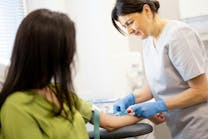Laboratory professionals know that a clean workspace is a safe workspace. Disinfection practices are at the core of maintaining a contamination-free environment, ensuring compliance, and protecting personnel, specimens, and the environment. But with evolving guidelines and new products entering the market, are you up to date with the best practices for laboratory decontamination? It is worthwhile to explore the latest in laboratory disinfection, from routine cleaning to selecting the best chemical germicides and understanding why some methods, like UV light, are less effective for bacterial or viral disinfection.
Decontamination basics
Decontamination is defined as minimizing the overall pathogenic microbial presence. For clinical and research laboratories, that microbial presence may exist in the form of bloodborne pathogens, bacteria, viruses, and even prions. The primary purpose of decontamination is to reduce the number of these contaminants in order to eliminate the probability of transmission or infection.
Cleaning and disinfection should be part of every lab’s daily routine. The goal is not just to wipe down surfaces, but to ensure that all potentially hazardous pathogens are eliminated. Work surfaces, benchtops, biosafety cabinets, and equipment should be disinfected at the beginning and end of each shift, as well as immediately following any spills or contamination events. Keep documentation of the workspace disinfection that occurs in each department.
High-touch areas such as door handles, keyboards, and centrifuge lids should also be included in routine cleaning schedules. The key is consistency: laboratory safety officers should implement and enforce standard operating procedures (SOPs) that outline when, where, and how disinfection should occur. Remember that all lab surfaces should be considered contaminated. That’s why gloves and lab coats are a must when working in the department, but disinfection practices should also be routine.
Not all disinfectants are created equally. Laboratories handle a variety of pathogens, and the effectiveness of a disinfectant depends on its active ingredients and proper use. A breakdown of commonly used chemical germicides includes the following:
- Alcohols (ethyl or isopropyl, 70–90%): Effective against many bacteria and viruses but not sporicidal. These work well for quick disinfection but evaporate quickly, which can reduce contact time.
- Quaternary ammonium compounds (Quats): Common in hospital settings, these are good general disinfectants but may not be effective against all pathogens, particularly non-enveloped viruses. These are often used in labs where employees may have allergies to bleach products.
- Hydrogen peroxide (3–7%): A strong oxidizing agent that works well against a broad range of microorganisms, including bacteria, viruses, and fungi.
- Phenolics: These are effective against bacteria and some viruses but they do leave an unwanted residue.
- Glutaraldehyde: A high-level disinfectant commonly used for sterilizing medical and laboratory instruments. However, it is hazardous and requires proper ventilation.
Bleach
Sodium hypochlorite, or bleach, remains the gold standard for laboratory disinfection. A 10% bleach solution is highly effective against bacteria, viruses, fungi, and even spores when given adequate contact time. The key to proper bleach disinfection is ensuring an adequate contact time—the amount of time the disinfectant remains on a surface before being wiped away or drying. For general disinfection, and to remove most bloodborne pathogens (HIV, HBV, HCV), at least one minute of drying time is necessary. To remove bacterial spores (e.g., Clostridium difficile), an extended dry time of ten to thirty minutes may be needed.
One major consideration with bleach is its corrosive nature. Frequent use on metal surfaces can lead to deterioration over time. This can be mitigated by using bleach alternatives, such as stabilized bleach solutions or hydrogen peroxide-based disinfectants that offer similar effectiveness with reduced corrosivity. Bleach use may also be followed by a water rinse in order to prevent damage to any surfaces.
Another disinfection consideration is the presence of prions in the lab. Prions are abnormally folded proteins which can be found in the spinal fluid and tissues of patients who have Creutzfeldt-Jakob disease (CJD), a rare but fatal, and rapidly progressive neurodegenerative disorder. While low-risk specimens containing prions may be handled and tested using standard precautions, spills of these specimens must be handled differently. Because prions are more difficult to inactivate than other bloodborne pathogens, spills should be soaked in undiluted bleach or a 1N sodium hypochlorite (NaOH) solution for at least one hour.
To ensure compliance with safety standards, laboratories should reference the EPA-registered disinfectant list (https://www.epa.gov/pesticide-registration/selected-epa-registered-disinfectants). This list categorizes disinfectants based on their effectiveness against specific pathogens, including emerging viral threats. Always check that the disinfectant being used is approved for the specific organisms of concern in your laboratory.
UV light
Ultraviolet (UV) light has been marketed as a powerful decontamination tool, but it comes with limitations that make it less ideal for bacterial or viral disinfection in routine lab use. UV light has limited surface penetration, it disinfects only the areas it directly reaches, meaning that shaded or covered spots remain unsterilized. UV light also exhibits inconsistent effectiveness. Bacterial spores and some viruses exhibit resistance to UV exposure, requiring long exposure times and precise conditions. Making matters worse, direct UV exposure can be harmful to human skin and eyes, making its use in occupied laboratory spaces a risk. While UV technology has applications in molecular and DNA decontamination and some high-level sterilization processes, it should not replace chemical disinfection as a primary method.
Formaldehyde
In histology laboratories, formaldehyde remains a critical disinfectant due to its ability to fix tissues and inactivate pathogens. However, it is also a carcinogen and respiratory hazard, requiring strict handling precautions. Formaldehyde should only be used in well-ventilated areas, preferably under fume hoods. Laboratory personnel must wear gloves, lab coats, and appropriate respiratory protection when handling formaldehyde solutions. Some histology equipment manufacturers recommend using formaldehyde as a disinfectant, but as with UV light, labs should consider safer substitutes that offer better disinfection without the associated health risks.
Conclusion
In order to ensure that the best laboratory decontamination practices are in place, consider following a routine cleaning schedule and ensure all surfaces are disinfected regularly and immediately after contamination or spill events. Choose the right disinfectant for the job. Match the disinfectant to the specific pathogens present in your lab environment. Be sure to let disinfectants remain on surfaces for the proper recommended contact time. A disinfectant is only effective if given enough time to work — don’t wipe it away too soon. Keep containers of disinfectants and wipes closed when not in use. Evaporation occurs quickly in the lab environment, and partially evaporated products lose effectiveness quickly. Make sure the disinfectants used in the lab are EPA-approved for their intended purpose.
Bleach is a corrosive chemical, so use it safely. While effective, bleach should be handled with care to prevent skin contact and damage to equipment and surfaces. Ensure a proper dilution of bleach mixtures. Check the concentration of undiluted bleach and calculate a proper 10% solution dilution. Not all bleach products are alike. If you make a bleach solution in your laboratory, be sure to make it fresh daily.
Maintaining a clean and contamination-free laboratory isn’t just about following the rules—it’s about creating a culture of safety and accountability. By staying informed on the latest disinfection practices, choosing the right germicides, and adhering to best practices, laboratory professionals can ensure a safer working environment while protecting the integrity of their work. The key to effective disinfection isn’t just what you use — it’s how you use it. Stay diligent, stay informed, and keep your lab clean!



